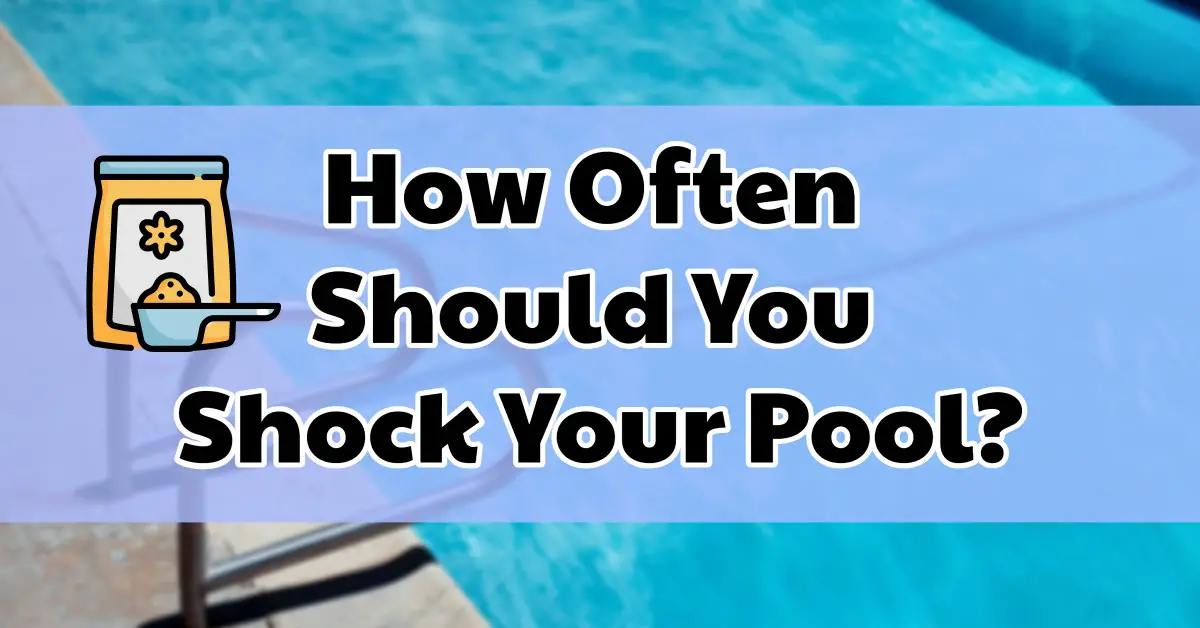How often should you shock your pool? This is the most commonly asked question.
Regularly shocking your pool is one of the best ways to keep it clean and clear. All you need to know are the seven shocking rules.
Let’s, Check it out.
What is Shock?
There is a difference between the actual chemical which is called Pool Shock and the action which is called shocking.
Pool Shock is a concentrated dose of Chlorine, there is also a non-chlorine version too.
Shocking is the process of adding high amounts of Chlorine to your pool that raise the free Chlorine level.
Why do we shock a pool?
Well, it’s like hitting a giant reset button. Pool shock destroys the algae and bacteria living in your pool and removes combined Chlorine molecules called chloramines.
When you are buying Pool Shock, look for the shock that contains at least 65 to 70% Calcium hypochlorite.
There’s also a non-chlorine shock that only helps to remove chloramines that will not raise the free chlorine level in your pool.
How often do you need to shock your pool?
#1. Shock your pool when the free Chlorine levels are off or when you smell Chlorine.
Regular testing will help you know if your pool water is outside the recommended free Chlorine levels.
Free Chlorine should be between 1 and 3 ppm, with 3 ppm (Parts Per Million) being ideal.
if you smell Chlorine, this indicates that the Chlorine is combined with ammonia and no longer sanitizing the water.
Shocking the water will free up effective Chlorine and eliminate the smell.
#2. Shock your pool when you open it.
This will help kill algae that have developed while it was closed. Balance your water first, adjusting things like pH and alkalinity.
Then we recommend using a double shock, which is twice the normal amount of shock to give your pool an initial bacterial killing whammy.
Use 2 pounds of pool shock for every 10,000 gallons of pool water, or 5 pounds of liquid shock for every 20,000 gallons of pool water.
#3. Shock your pool every week for normal maintenance.
You will kill more and more bacteria every time you shock your pool. Weekly shocking is a great way to keep your Chlorine levels up and prevent algae grow.
If no one has been swimming in your pool and you don’t get any weird weather, feel free to skip a week.
#4. Shock after heavy use.
If you’ve had a party or you’ve been swimming in your pool a lot, you wanna push that big reset button and give your pool a shock.
People carry lots of bacteria and the Chlorine level drops when tons of people have been in the water.
#5. Shock after heavy rain
because it can carry contaminants into your pool and mess with your pH levels.
So shocking is a great way to reset after a storm.
#6. Shock after super sunny hot weather.
When temperatures get too high, the strength of your Chlorine can decrease and bacteria can grow.
#7. The shock when closing your pool.
Your future self will thank you for this one.
Shocking your pool before you close, means you probably wouldn’t be greeted by an algae nightmare when you open it up again next season.
Now you know how often to shock.
when is the right time to add shock?
The answer, at night.
Chlorine in Pool Shock is unstabilized and the sun will burn off the Chlorine very quickly.
So to get the most out of your shock treatment, wait until the sun goes down before adding shock to your pool.
And, wait at least eight hours after shocking to go swimming again. This is another great
reason to shock overnight.
When you are ready to shock, first check your pH and alkalinity levels to make sure that they are balanced.
You can dissolve shock ahead of time in a five-gallon bucket of pool water and stir gently.
Be sure to always follow the instructions on your Pool Shock package since some shock doesn’t
need to be pre-dissolved.
And if you do this, wear protective chemical resisting goggles, masks, and gloves.
Run your pool pump and pour the shock mixture from the bucket into the pool around the edges of the pool.
And then let the pump run for at least eight hours overnight and then test the water the next morning.
You wanna wait for that free Chlorine level to drop down to at least 3 ppm (Parts Per Million) before you go swimming.
And that’s it.
That’s all about how often you should shock your pool.
I hope, this article will clear all your doubts.
